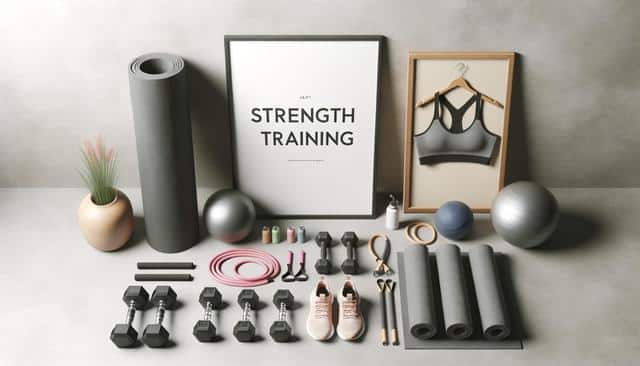Strength Training Routine for Women: A Balanced Approach to Fitness
Unlock your potential with our Strength Training for Women Guide! Discover the full body strength training routine for women at home, designed for all fitness levels. Build strength, boost metabolism, and achieve your fitness goals with effective, empowering workouts. Start your journey to a stronger you!

Why Strength Training Matters for Women
Strength training is a vital component of any fitness routine, and it offers numerous benefits specifically for women. While cardiovascular exercise is often emphasized, incorporating resistance-based workouts can lead to improved muscle tone, increased metabolic rate, better bone density, and enhanced overall health. Contrary to common myths, strength training does not result in bulkiness; instead, it helps create a lean and defined physique. For women of all ages, lifting weights or using body resistance can lead to substantial improvements in physical and mental well-being.
Additionally, strength training supports hormonal balance and can help manage stress levels. As women age, maintaining muscle mass becomes increasingly important for preserving mobility and preventing injury. This type of training also aids in improving posture and reducing the risk of chronic conditions such as osteoporosis and type 2 diabetes. Whether you’re new to fitness or looking to enhance your current routine, integrating strength exercises is a smart, sustainable choice.
Getting Started: Equipment and Setup
You don’t need a gym membership to start a strength training routine. With minimal equipment or even just body weight, you can perform highly effective workouts from the comfort of your home. Here’s a basic list of what you might need to begin:
- Yoga mat or exercise mat for comfort
- Set of dumbbells or resistance bands
- Chair or sturdy bench for support
- Water bottle and towel
Beginners can start with light weights or use body weight to learn proper form and technique. As you build strength, you can gradually increase resistance. It’s also a good idea to designate a specific workout space at home that is clean and free of distractions. This helps build a consistent habit and makes your routine easier to maintain.
Before beginning any workout, a proper warm-up is essential. Spend 5 to 10 minutes doing light cardio such as marching in place, jumping jacks, or arm circles. This prepares your muscles for exertion and reduces the risk of injury. Following your strength session, cooling down with gentle stretches can aid in recovery and flexibility.
Sample Full Body Strength Routine
This sample routine is designed to target all major muscle groups in a balanced way. For beginners, aim to complete this circuit 2 to 3 times per week on non-consecutive days. Adjust the number of repetitions and sets based on your fitness level.
- Bodyweight Squats – 3 sets of 12 reps
- Push-Ups (knee or full) – 3 sets of 10 reps
- Bent-Over Rows with Dumbbells – 3 sets of 12 reps
- Glute Bridges – 3 sets of 15 reps
- Plank Hold – 3 rounds of 30 seconds
- Standing Overhead Press – 3 sets of 10 reps
These exercises collectively work the lower body, upper body, and core. As you progress, you can increase the intensity by adding more weight, increasing the number of sets, or incorporating advanced movements. Always ensure your form is correct to get the most benefit and avoid injuries.
Tips for Staying Consistent
Consistency is key to seeing results from your strength training routine. It’s normal to feel sore in the beginning, but staying committed will help your body adapt and grow stronger. Here are a few tips to help maintain motivation and consistency:
- Set realistic and specific goals (e.g., “I want to do 10 full push-ups in 8 weeks”)
- Track your progress in a fitness journal or app
- Schedule workouts as you would important appointments
- Find a workout buddy or join an online community for support
- Celebrate small victories, like completing a new set or adding weight
It’s also important to listen to your body and rest when needed. Recovery days are part of the process and allow your muscles to repair and grow. By creating a realistic and enjoyable routine, you’ll be more likely to stick with it long-term.
Adapting Your Routine Over Time
As you become more comfortable with strength training, it’s beneficial to reassess your routine every few weeks. Progressive overload—gradually increasing the demand on your muscles—is essential for continued improvement. You can do this by:
- Increasing weight or resistance
- Adding more repetitions or sets
- Reducing rest time between exercises
- Incorporating new movements or variations
Also, consider focusing on specific goals such as building endurance, enhancing muscle definition, or improving functional strength. For example, if you want to improve your core, you might add exercises like Russian twists or leg raises. Tailoring your routine to your evolving objectives keeps training engaging and effective.
It’s also helpful to periodically evaluate your nutrition, sleep, and stress levels, as these factors significantly influence your training results. A holistic approach ensures you stay balanced and avoid burnout. Remember, progress takes time, and every step forward is a victory worth recognizing.
Conclusion: Empower Your Fitness Journey
Strength training offers a rewarding path to improved health, confidence, and physical ability for women of all backgrounds. By incorporating a well-rounded routine that fits your lifestyle, you not only enhance your physical fitness but also build resilience and self-assurance. Starting small and staying consistent will lead to meaningful results over time. This guide serves as a foundation for creating a sustainable, empowering workout habit that supports your long-term wellness journey. Embrace your strength, move with purpose, and enjoy the benefits of a healthier, stronger you.